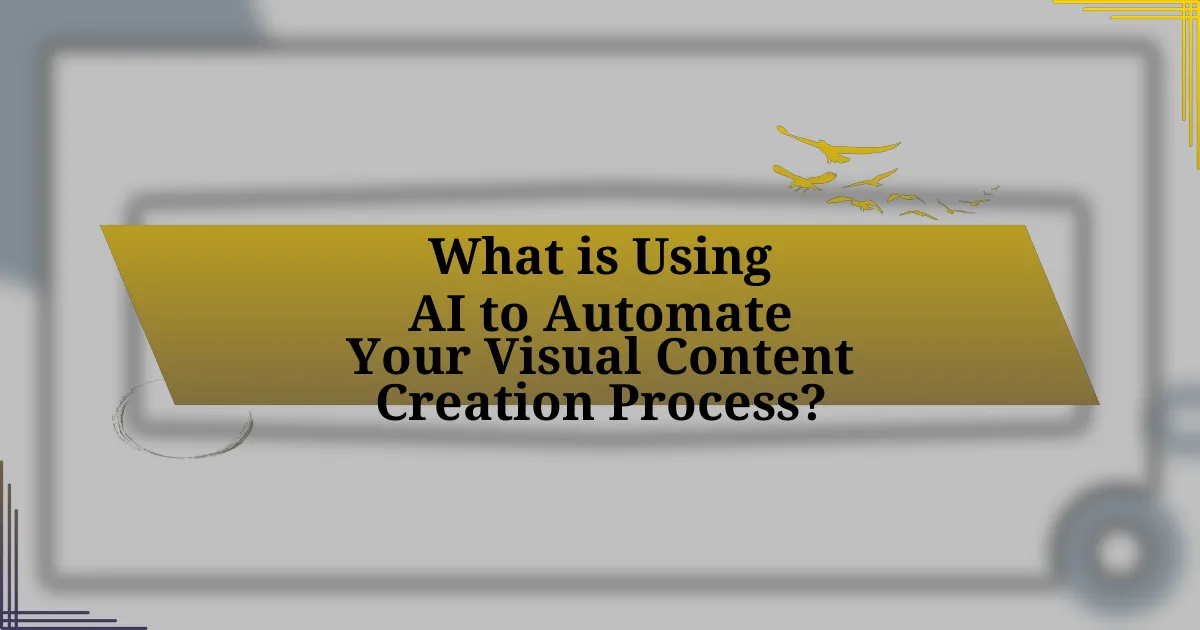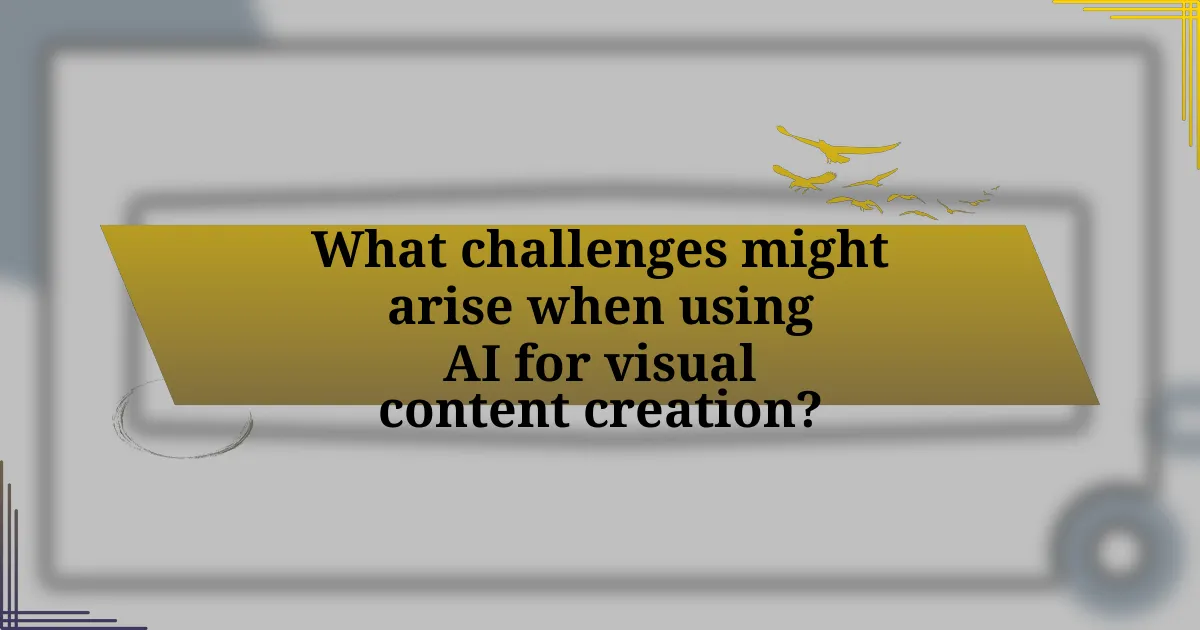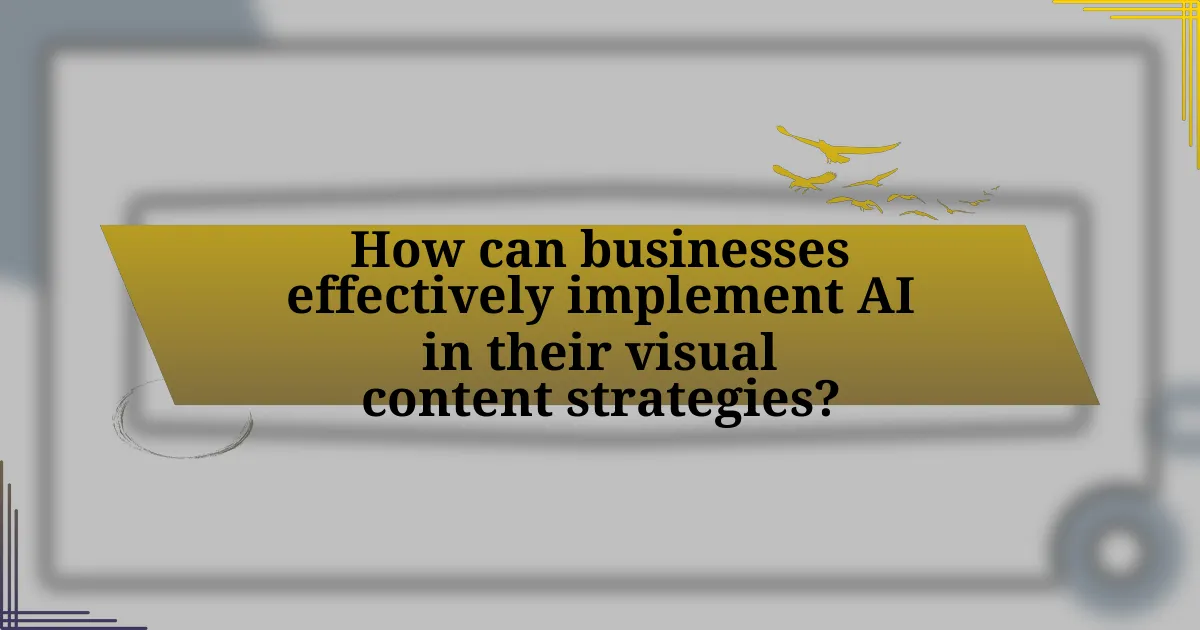Using AI to automate visual content creation involves employing artificial intelligence technologies to enhance the production of images, videos, and graphics, significantly reducing the time and effort required for manual design. Key contributions of AI include automating design processes, generating high-quality visuals, and optimizing workflows through advanced technologies such as deep learning and computer vision. The article explores the benefits of AI integration, including increased productivity and cost savings, while also addressing challenges such as quality concerns and potential biases in AI-generated content. Additionally, it outlines best practices for implementing AI tools effectively and ensuring collaboration between AI and human creators to maximize the advantages of this technology in visual content strategies.

What is Using AI to Automate Your Visual Content Creation Process?
Using AI to automate your visual content creation process involves leveraging artificial intelligence technologies to streamline and enhance the production of visual materials such as images, videos, and graphics. This automation can significantly reduce the time and effort required for content creation by utilizing algorithms that generate, edit, and optimize visual assets based on predefined parameters or user inputs. For instance, tools like Canva and Adobe Sensei employ AI to suggest design layouts and automate repetitive tasks, thereby increasing efficiency and creativity in visual content production.
How does AI contribute to visual content creation?
AI significantly enhances visual content creation by automating design processes and generating high-quality images. Tools like Adobe Sensei and Canva utilize machine learning algorithms to analyze user preferences and create tailored visual assets efficiently. For instance, AI can generate graphics, suggest layouts, and even edit photos, reducing the time and effort required for manual design. According to a report by McKinsey, companies that integrate AI into their creative processes can increase productivity by up to 30%. This demonstrates that AI not only streamlines workflows but also improves the overall quality of visual content produced.
What technologies are involved in AI-driven visual content creation?
AI-driven visual content creation involves technologies such as deep learning, computer vision, natural language processing, and generative adversarial networks (GANs). Deep learning algorithms enable the analysis and generation of images by learning from large datasets, while computer vision techniques allow machines to interpret and understand visual information. Natural language processing facilitates the generation of visual content based on textual descriptions, and GANs are specifically designed to create new images by pitting two neural networks against each other, enhancing the quality and realism of generated visuals. These technologies collectively enhance the efficiency and creativity of visual content production.
How do these technologies enhance the creative process?
These technologies enhance the creative process by streamlining workflows and providing innovative tools that facilitate idea generation and execution. For instance, AI algorithms can analyze vast datasets to identify trends and generate design suggestions, allowing creators to focus on refining their concepts rather than starting from scratch. Additionally, automation tools can handle repetitive tasks, such as resizing images or formatting layouts, which frees up time for artists and designers to explore more creative avenues. Research indicates that companies utilizing AI in creative processes report a 30% increase in productivity, demonstrating the tangible benefits of integrating these technologies into visual content creation.
What are the key benefits of automating visual content creation with AI?
Automating visual content creation with AI significantly enhances efficiency and creativity. This technology allows for rapid generation of high-quality images, videos, and graphics, reducing the time and resources traditionally required for manual content creation. For instance, AI tools can produce visuals in minutes, compared to hours or days for human designers, enabling businesses to respond quickly to market demands. Additionally, AI can analyze data to tailor content to specific audiences, improving engagement rates. Studies indicate that companies using AI for content creation see a 30% increase in productivity and a 20% boost in audience interaction, validating the effectiveness of this approach.
How does automation improve efficiency in content production?
Automation improves efficiency in content production by streamlining repetitive tasks, reducing human error, and accelerating the overall workflow. For instance, automated tools can handle tasks such as scheduling posts, optimizing images, and generating reports, which allows content creators to focus on higher-level strategic activities. According to a study by McKinsey, automation can increase productivity by up to 40% in certain tasks, demonstrating its significant impact on efficiency in content production processes.
What cost savings can businesses expect from using AI?
Businesses can expect significant cost savings from using AI, particularly in areas such as labor reduction, efficiency improvements, and error minimization. For instance, AI can automate repetitive tasks in visual content creation, which traditionally require substantial human resources. According to a report by McKinsey, companies that implement AI can reduce operational costs by up to 30% through automation and improved processes. Additionally, AI-driven tools can enhance productivity by streamlining workflows, allowing teams to focus on higher-value tasks, thus further driving down costs associated with project delays and resource allocation.

What challenges might arise when using AI for visual content creation?
Challenges that might arise when using AI for visual content creation include issues related to quality, originality, and ethical considerations. AI-generated visuals may lack the nuanced creativity and emotional depth that human artists provide, leading to content that feels generic or uninspired. Additionally, there is a risk of copyright infringement, as AI models can inadvertently replicate existing works, raising legal concerns. Furthermore, biases present in training data can result in the generation of content that perpetuates stereotypes or excludes certain demographics. These challenges highlight the need for careful oversight and ethical guidelines in the deployment of AI technologies in visual content creation.
How can businesses address potential biases in AI-generated content?
Businesses can address potential biases in AI-generated content by implementing diverse training datasets and regular audits of AI outputs. Utilizing diverse datasets ensures that the AI is exposed to a wide range of perspectives, reducing the likelihood of reinforcing existing biases. Regular audits involve systematically reviewing AI-generated content for biased language or imagery, allowing businesses to identify and rectify issues promptly. Research indicates that diverse training data can significantly improve the fairness of AI systems, as demonstrated in studies by the MIT Media Lab, which found that AI models trained on more inclusive datasets performed better in reducing bias.
What steps can be taken to ensure diversity in AI outputs?
To ensure diversity in AI outputs, organizations should implement diverse training datasets, involve multidisciplinary teams in AI development, and regularly audit AI systems for bias. Diverse training datasets that represent various demographics and perspectives help prevent the reinforcement of existing biases. Involving multidisciplinary teams, including experts from different cultural, social, and professional backgrounds, fosters a broader understanding of diversity issues. Regular audits of AI systems can identify and mitigate biases, ensuring that outputs reflect a wide range of viewpoints and experiences. These steps are supported by research indicating that diverse teams produce more innovative solutions and that biased datasets lead to skewed AI outputs.
How can companies monitor and evaluate AI performance?
Companies can monitor and evaluate AI performance by implementing key performance indicators (KPIs) tailored to specific AI applications. These KPIs may include accuracy, precision, recall, and F1 score, which quantitatively assess the AI’s effectiveness in tasks such as image recognition or content generation. For instance, a study by Google Research demonstrated that using precision and recall metrics can significantly enhance the evaluation of AI models in visual content creation, ensuring that the generated images meet quality standards. Additionally, companies can utilize A/B testing to compare different AI models or algorithms, providing empirical evidence of performance differences. Regular audits and feedback loops also help in refining AI systems, ensuring they adapt to changing requirements and maintain optimal performance over time.
What are the limitations of AI in visual content creation?
AI in visual content creation has several limitations, including a lack of creativity, inability to understand context, and challenges in producing high-quality images. These limitations arise because AI relies on existing data and algorithms, which restrict its ability to generate truly original ideas or concepts. For instance, AI-generated images often lack the nuanced understanding of cultural references or emotional depth that human creators possess, leading to outputs that may not resonate with audiences. Additionally, AI systems can struggle with complex visual tasks, such as accurately depicting intricate details or maintaining consistency across a series of images. Research indicates that while AI can assist in generating visual content, it cannot fully replicate the human touch required for effective storytelling and emotional engagement.
How does AI struggle with creativity compared to human designers?
AI struggles with creativity compared to human designers primarily due to its reliance on existing data and algorithms, which limits its ability to generate truly novel ideas. While human designers can draw from personal experiences, emotions, and cultural contexts to create unique and innovative designs, AI typically analyzes patterns in large datasets to produce outputs that may lack originality. For instance, a study by the Massachusetts Institute of Technology found that AI-generated art often mimics styles and trends rather than creating groundbreaking concepts, highlighting its limitations in creative thinking.
What are the risks of over-reliance on AI tools?
Over-reliance on AI tools can lead to significant risks, including loss of critical thinking skills and reduced human oversight. When individuals depend heavily on AI for decision-making, they may neglect to analyze information independently, resulting in poor judgment and oversight. A study by the Pew Research Center found that 48% of experts believe that excessive reliance on AI could diminish human skills and capabilities. Additionally, over-reliance can create vulnerabilities in data security, as AI systems may be exploited if not monitored properly. This highlights the importance of maintaining a balance between utilizing AI tools and ensuring human involvement in the creative and decision-making processes.

How can businesses effectively implement AI in their visual content strategies?
Businesses can effectively implement AI in their visual content strategies by integrating AI-driven tools for content creation, personalization, and analytics. These tools can automate the design process, enabling businesses to generate high-quality visuals quickly and at scale. For instance, platforms like Canva and Adobe Spark utilize AI to suggest design elements based on user preferences and trends, streamlining the creative process. Additionally, AI can analyze audience engagement data to tailor visual content to specific demographics, enhancing relevance and effectiveness. Research indicates that companies using AI for content personalization see a 20% increase in engagement rates, demonstrating the tangible benefits of AI integration in visual content strategies.
What best practices should be followed when integrating AI tools?
When integrating AI tools, it is essential to ensure alignment with business objectives. This alignment guarantees that the AI implementation addresses specific needs and enhances productivity. Additionally, conducting thorough research on available AI tools is crucial; selecting tools that are user-friendly and compatible with existing systems can significantly improve the integration process.
Establishing a clear data strategy is another best practice; this involves identifying the data required for AI training and ensuring data quality and accessibility. Furthermore, involving stakeholders from various departments during the integration process fosters collaboration and helps in addressing potential challenges early on.
Regularly monitoring and evaluating the performance of AI tools is vital to ensure they meet the desired outcomes and to make necessary adjustments. Training employees on how to effectively use these tools enhances adoption and maximizes their benefits.
These practices are supported by industry reports, such as the McKinsey Global Institute’s findings, which highlight that organizations that prioritize alignment, stakeholder involvement, and continuous evaluation achieve greater success in AI integration.
How can teams ensure collaboration between AI and human creators?
Teams can ensure collaboration between AI and human creators by establishing clear communication channels and defining roles for each participant. This approach allows human creators to leverage AI’s capabilities for data analysis and content generation while maintaining creative control and oversight. For instance, a study by McKinsey & Company found that organizations that integrate AI tools effectively report a 20-30% increase in productivity, highlighting the benefits of collaboration. By fostering an environment where AI assists rather than replaces human creativity, teams can enhance their visual content creation processes.
What training is necessary for staff to utilize AI tools effectively?
Staff training necessary for effective utilization of AI tools includes understanding AI fundamentals, hands-on experience with specific AI applications, and data literacy. Training programs should cover the principles of machine learning, the functionality of the AI tools being used, and best practices for data management and analysis. Research indicates that organizations that invest in comprehensive training see a 20% increase in productivity when using AI tools, as employees become more adept at leveraging these technologies for their tasks.
What are some practical tips for maximizing the benefits of AI in visual content creation?
To maximize the benefits of AI in visual content creation, leverage AI tools for automating repetitive tasks, enhancing creativity, and optimizing workflows. Utilizing AI-driven platforms like Canva or Adobe Sensei can streamline design processes, allowing creators to focus on innovative aspects of their projects. Additionally, employing AI for data analysis can provide insights into audience preferences, enabling tailored content that resonates better with viewers. Research indicates that companies using AI in content creation report a 30% increase in efficiency, demonstrating the tangible advantages of integrating AI into visual workflows.
How can businesses measure the success of their AI-driven content strategies?
Businesses can measure the success of their AI-driven content strategies by analyzing key performance indicators (KPIs) such as engagement rates, conversion rates, and return on investment (ROI). Engagement rates can be assessed through metrics like likes, shares, comments, and time spent on content, indicating how well the audience interacts with the AI-generated material. Conversion rates reflect the percentage of users who take desired actions, such as signing up for newsletters or making purchases, demonstrating the effectiveness of the content in driving business goals. ROI can be calculated by comparing the revenue generated from AI-driven content against the costs associated with its creation and implementation, providing a clear picture of financial success. According to a report by McKinsey, companies that effectively leverage AI in their content strategies can see up to a 20% increase in productivity, further validating the importance of these metrics in measuring success.
What common pitfalls should be avoided when using AI for content creation?
Common pitfalls to avoid when using AI for content creation include over-reliance on AI-generated content, lack of human oversight, and neglecting audience engagement. Over-reliance on AI can lead to generic or repetitive content that fails to resonate with the target audience, as AI lacks the nuanced understanding of human emotions and cultural context. Lack of human oversight can result in inaccuracies or inappropriate content being published, as AI may misinterpret prompts or generate misleading information. Neglecting audience engagement can diminish the effectiveness of the content, as AI may not adequately address the specific needs or preferences of the audience, leading to lower interaction rates. These pitfalls highlight the importance of balancing AI capabilities with human creativity and insight in the content creation process.
